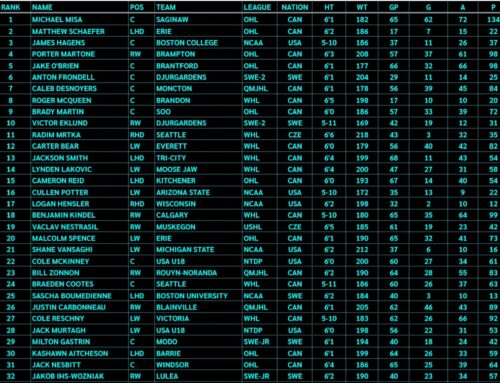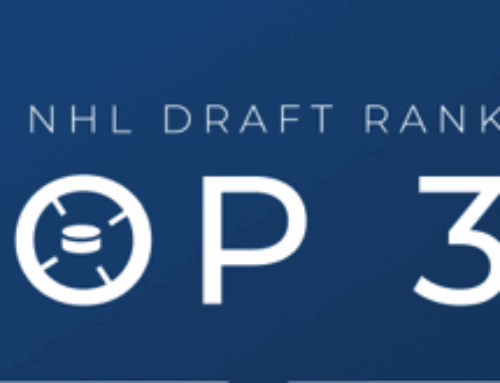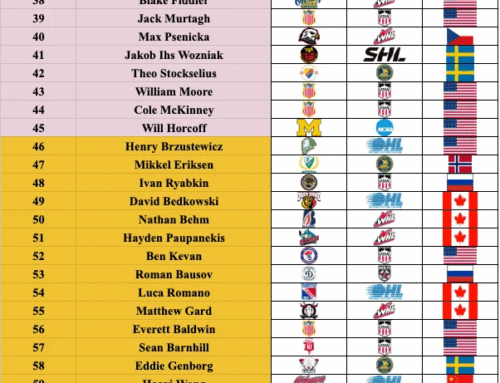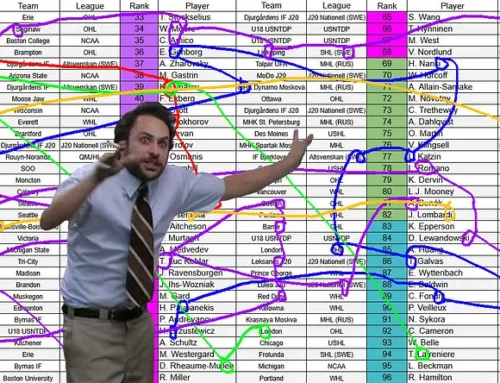PNHLe Organizational Rankings: 5 to 1
Mason Black
2019-10-03
***
Title photo credit to NHLPA.com and Getty Images
This is the fifth part of a series where I will be ranking NHL organizations based on a new PNHLe model that I have spent the better part of the summer updating.
If you are unfamiliar with PNHLe, or would like a more in-depth explanation on why these rankings are different compared to traditional real-world prospect grades, or those explicitly for fantasy purposes, I highly recommend you read through the introduction to the first article, which gives a better description. While you are at it, why not grab a cup of coffee and work your way through all teams that have been ranked so far, which you can find here:
PNHLe Organizational Rankings: 10-6
PNHLe Organizational Rankings: 15 – 11
PNHLe Organizational Rankings: 20 – 16
PNHLe Organizational Rankings: 25 – 21
PNHLe Organizational Rankings: 31 – 26
PNHLe is a model that is used to predict a prospect’s NHL point potential in the prime of their career, and something I have re-evaluated, recalculated and re-examined with the sole purpose of making the formula more precise.
The culmination of every hockey season brings forth a massive allocation of new data that can be used to make the model more accurate. Many NHL players hit new career highs, while others show consistency in their point production, which allows for minor tweaks to the overall PNHLe formula.
Looking back to the leagues NHL players toiled in prior to making the leap to the NHL can give great insight into what a typical point production looks like for many current prospects playing all over the world.
Simply put, PNHLe tries to gauge a prospect’s point potential in the NHL. How many points will an 18-year old prospect in the OHL obtain, who posted a point per game, if they make it to the show? PNHLe allows us the ability to compare prospects from different leagues, at different ages and different positions to give a snapshot of just how good they are doing. As a fantasy manager, you can use that knowledge to take advantage and snag a player well before anyone else in your league. As you can imagine, the model should not be used as a sure-fire way of assessing a player’s ability or probability of making it to the top level, but it is yet another piece of a comprehensive list of resources you can use.
Let us take a look at the next set of rankings:
5th – New Jersey Devils – PNHLe: 63.8 (Avg.)
GM Ray Shero did his best this off-season to surround the first overall Triple-H combo (Hall, Hischier and Hughes) with some key acquisitions that will allow the team to make a push into the playoffs in an increasingly competitive division. It certainly helps to have a sure-fire superstar and a legitimate future franchise forward protégé added to your organizational depth chart, which is exactly what the Devils got when they won the draft lottery and chose Jack Hughes at first overall. The USNDTP is easily the most difficult team to try to model because of their wacky schedule and strength of competition, and that means a player like Hughes has a much higher ceiling than his PNHLe would suggest. In fact, in his draft minus-one season his PNHLe was an astonishing 107!
Outside of Jack Hughes, the Devils boast a very interesting set of prospects with NHL potential. Ty Smith finished second overall amongst CHL defensemen in PNHLe ahead of some very impressive names. Smith often times gets overlooked in discussions regarding the noteworthy group of young defenders that were selected at the top of the 2018 NHL draft. However, Smith could surprise and challenge as one of the top point producers compared to other defensemen that were drafted ahead of him, when things are all said and done.
Reilly Walsh is another intriguing prospect who will be given more responsibility with the departure of fellow Harvard defender, Adam Fox. Although Walsh spent significant time with Fox at both even strength and special teams, he showed that he was more than capable when the dangerous duo was separated. However, Walsh will be expected to carry the load on a stacked ECAC roster.
Former 2017 second round pick, Jesper Boqvist, put many of the consistency issues that plagued him in the rear-view mirror this past season. He will look to use the offensive side of his game as a springboard when he attempts to crack the Devils’ roster this fall. He will most likely spend some time in the AHL this season, but could prove that he is more than capable of becoming a depth option in New Jersey, before he eventually works his way onto a scoring role in the next couple of seasons.
The Devils certainly do not have one of the deepest prospect pools, but a single franchise player in the midst of other talented players has thrust New Jersey into the top-five.
4th – New York Rangers – PNHLe: 64.6 (Avg.)
For a team that has a long history of trading away its top picks and prospects, New York has amassed an impressive list of high upside players. In fact, no team has made a more drastic improvement in its prospect depth chart in such a small amount of time as the New York Rangers. Winning the second draft lottery position certainly does not hurt, but GM Jeff Gorton has made many other accompanying transactions that will set the franchise up for success for many years to come. Kappo Kakko is clearly the golden boy of the system and will get an immediate look in a top-six role. There is not much else to say about Kakko that has not already been said because he has shown he is more than capable of controlling the game even against the world’s best players.
It may be hard to believe that another prospect besides Kakko is at the top of this list, but it only highlights how incredible Adam Fox’s season was last year when he scored 48 points in only 33 games as a defenseman. To put that into perspective, Fox had the highest points per game average in the entire NCAA, and the second highest PNHLe from an NCAA defenseman since I have been tracking the stat back to 2005. Concerns about his defensive play are warranted, but he may prove that the offensive parts of his game are simply too valuable to keep him off of the ice, especially the power play, and for fantasy GMs that can be absolute gold.
Vitali Kravtsov is another example of a player whose PNHLe is significantly lower than his true value. 21 points in 50 KHL games is nothing to sneeze at, but the volatility of the highest Russian league makes long-term NHL projections extremely difficult to forecast. Nonetheless, you have nothing to worry about if Kravtsov is a part of your fantasy team, and if you are not lucky enough to have him, it may be worthwhile to spend a significant amount to obtain his services as his stock is only going to rise.
K’Andre Miller is another gifted defenseman in an organization that seems as though they have a never-ending supply. I suspect he will finish the year with the University of Wisconsin before signing a professional contract with the Rangers and could see time when his collegiate season is complete. Miller was considered a bit of a raw prospect when New York selected him at 22nd overall, but his progress has evolved by leaps and bounds in the next year where the sky is the limit in terms of his ultimate upside.
The Rangers’ quick turnaround will be predicated on the fulfilment of its top prospects reaching their potential as soon as possible. New York has a wealth of talent scattered throughout its organization and key players already contributing at some of the most important positions. How quickly the Rangers rise back up to the top tier of the NHL will be determined by the chemistry created when the youngsters are infused into the line-up.
3rd – Philadelphia Flyers – PNHLe: 65 (Avg.)
The Flyers have been near the top of both real world and fantasy prospect team rankings for the last several years. It is a testament to Philadelphia’s amateur scouting, draft analysis and player development departments, and once again they find themselves as a part of the crème of the crop. Despite the graduation of many top draft picks recently, the next wave of players are very close to making an NHL impact, which should quickly bolster an organization that has continually fallen short over the past 30-plus years.
Morgan Frost and Joel Farabee, the Flyers’ respective first round picks from 2017 and 2018, have made huge strides in terms of their development. They will be knocking on the NHL’s door and could both easily top out as first line players after a couple of years of pro acclimatization.
In the 2019 draft the Flyers clearly made offensive potential a priority with Cam York and Bobby Brink. Both players are considered undersized for their positions, but tore apart the opposition’s defense and found the score sheet more times than not. York and Brink may require more a bit extra development time in the NCAA but will be given ample responsibility to allow their offensive potential to percolate on scoring lines. Fortunately, the Flyers have a stockpile of NHL quality young defensemen that have recently, or are on the verge of graduating in the near future, so they can afford to be patient with York.
The City of Brotherly Love is not known for its patience, so the time is now for the Flyers’ young guns to take a step forward at the top level. Philadelphia is very fortunate that they have prospect depth at every position, which is the perfect recipe when the free agent taste buds start to water the mouths of notable veteran palates.
2nd – Colorado Avalanche – PNHLe: 67.8 (Avg.)
What do you get when you mix one of the most potent offensive NHL teams carried by a first line of superstars, with one of the most talented prospect pools in the NHL? We are about to find out. Colorado has been opportunistic when drafting inside the top-five in two of the last three drafts. Now, they have arguably the top two defensive prospects in the entire NHL, each with their own unique skillset that forecasts future Norris capacity.
Cale Makar is my frontrunner for this season’s Calder Trophy. Not only did the Avalanche make room for him by moving the final year of Tyson Barrie’s contract to open up a spot on the first line pairing. You get the sense that Makar could go wire to wire quarterbacking the top power play unit.
Bowen Byram was the hands-down top defenseman in the 2019 draft, and although he did not fit the Avalanche’s team needs at the time, Colorado did not hesitate to select what they felt was the best player available when they nabbed him at fourth overall. 71 points in 67 games for the draft eligible blue-liner is an extraordinary achievement that not many defensemen have bettered in the WHL. Colorado’s other first round pick, Alex Newhook, was not eligible for these rankings because he played in the BCHL; a league that is not tracked. Expect big things from Newhook when he attends Boston College as a freshman this year.
The depth chart falls off fairly considerably after Colorado’s two future star defenders, but Alex Beaucage could prove to be one of the steals of the 2019 draft. Beaucage helped propel the Rouyn-Noranda Huskies to a Memorial Cup championship, and although he was only able to find the score sheet twice during the five games he played in the tournament, he was able to impose his size while playing a very mature game considering his age. Expect another big jump in point totals next season that will have many scouts scratching their heads wondering how he slid to the third round.
1st – Los Angeles Kings – PNHLe:
L.A. has seen a sharp decline after dominating the West for long stretches over the past decade, but the Kings have accumulated a long list of prospects with high potential. I would wager a bet that you did not think the Los Angeles Kings would rank first of all 31 NHL teams, and by a larger PNHLe margin than any other consecutive pair of teams in this ranking. However, what scared away many other teams in the last couple of drafts has allowed Los Angeles to select a couple of boom or bust candidates in the second round with some of the highest NHL point potential that was calculated by PNHLe.
The jury is still out on how a first time draft eligible, 100-plus point scorer in the OHL could ever get outside of the first round. Yet, Arthur Kaliyev was not left waiting for long on day two of the 2019 draft. Despite times when he clearly took shifts off and was accused of having lackluster motivation, it was a well-warranted risk considering there may be more untapped potential left in the natural goal scorer.
Akil Thomas has gotten progressively better and has put to rest many of the knocks that allowed him to drop to the end of the second round in 2018. Another 100-plus point prospect, Thomas is a player whose stock will continue to rise over the course of this season, as he will be expected to lead the Niagara IceDogs in scoring as its captain.
What more can be said about dynamic pivot Alex Turcotte, who seemed to land in the lap of the Kings when he was taken at fifth overall. Turcotte is going to be a massive part in the future success of the Kings, as they boast one of the oldest rosters in the NHL. He possesses an imposing toolkit that should help to make him a perennial all-star.
Jaret Anderson-Dolan may play second fiddle to Turcotte for much of his career, but he has the leadership qualities that could translate into the future Captain of the franchise. Nonetheless, it makes for a very powerful future one-two-punch, for the Kings. I regard Anderson-Dolan as one of the most underrated prospects in the game, and is a player who may take a little bit longer to finally realize his point potential, but once he is there could be a very important part of your fantasy roster.
If you have enjoyed today’s breakdown of using PNHLe to predict a prospect’s future success at the NHL level, please stay tuned as I complete an article once per month here at DobberProspects, while also covering the players in Vegas Golden Knight’s system.
I have also created the NHL Rank King app where you can find full organizational point totals for prospects, PNHLe rankings among many other fantasy resources. I consult the app on every fantasy hockey decision I evaluate and every feature added to the app is with the sole purpose of helping with the choices surrounding my fantasy hockey teams. It is completely free, so hopefully you will find it useful as well!
You can download the iPhone version here, and I have recently created an Android version as well.
If you are on Twitter, please give me a follow @NHLRankKing.












